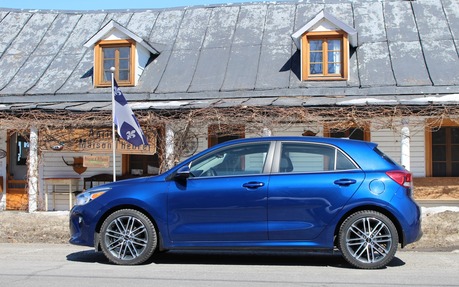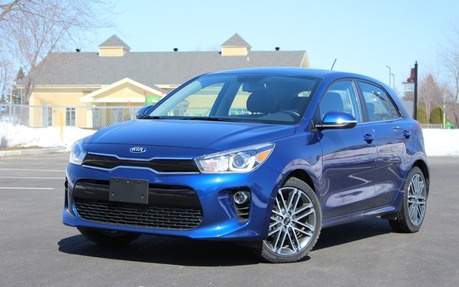2018 Kia Rio: Trying to Turn the Tide
The subcompact-car segment in North America is struggling for three reasons. One, SUVs are now the hot item. Two, compact-sized cars cost only a few bucks more a month. Three, gasoline still isn’t expensive enough.
A small car such as the redesigned 2018 Kia Rio has a lot going for it, and will fulfill the needs of many people in search of reliable, stylish and comfortable transportation. So far, Canadian consumers have responded, as the Rio’s sales have increased by almost 50% in the first half of 2018 compared to the same period in 2017. That’s a significant gain, but is it enough?
- Also: 2018 Kia Rio5: Fully Loaded for Under $15,000
- Also: Genesis, Kia and Hyundai Make All-Korean J.D. Power Quality Podium
The Hyundai Accent—the Rio’s cousin that shares platform, powertrain and other stuff—outsells the Kia, the Toyota Yaris, the Honda Fit, the Chevrolet Sonic, the Ford Fiesta and the Nissan Versa Note by a wide margin. This means the Koreans are pretty much dominating the subcompact car segment right now. They’re obviously doing something right.
The 2018 Kia Rio LX starts out at $14,795, before freight and delivery charges, in elegant sedan form, while the crafty 5-door version is $200 more. For that sum, we get power-adjustable and heated mirrors, keyless entry, heated front seats and steering wheel as well as a four-speaker sound system with five-inch display with USB port and Bluetooth connectivity. Adding air conditioning and cruise control, which means stepping up to the LX+, in addition to an automatic transmission, raises to price to $17,795 ($17,995 for the Rio 5-door), which is a good deal.

Our test car, a Rio EX Sport hatchback, is listed at $22,045 and includes 17-inch alloy wheels, a seven-inch touchscreen with Apple CarPlay and Android Auto integration, a power sunroof and automatic climate control, among other things. It’s still a good price, but a Kia Forte—or a Honda Civic, a Toyota Corolla and a Hyundai Elantra for that matter—will offer more rear-seat interior space and cargo room, more power and more overall refinement. So, it’s better to check out more affordable trim levels of the Rio.
Power comes from a 1.6-litre four-cylinder engine, basically the same one as in the previous-generation Rio. However, it’s been returned to deliver more midrange torque and improved fuel economy. Output drops from 137 to 130 horsepower, torque is down from 123 to 119 pound-feet, but consumption is down by about 0.3 L/100 km, with a combined average of 7.5. And that’s with either the six-speed manual transmission or the six-speed automatic. We managed 7.6 L/100 km during our test. By the way, for the 2019 model year, the Rio will swap its conventional automatic for a continuously variable unit, which should lower fuel consumption even more.
The 2018 Kia Rio is fun to drive, as long as you don’t expect it to perform like a MINI or a Ford Fiesta ST. Power is aplenty for the daily grind, and the engine isn’t too noisy at wide-open throttle. The ride quality of subcompact cars has improved considerably in the last ten years, and together with a well-crafted cabin, many consumers could downsize to a Rio without the feeling of buying a “cheap” vehicle.

As good as the Rio is, it’s not the most spacious in its category. The Versa Note is the passenger-hauling champ with its generous rear-seat legroom, while the Fit is tops in regards to maximum cargo space with the rear seatbacks folded. The Rio’s max volume of 929 litres, which partly has to do with an uneven flat floor, pales in comparison to the Fit’s 1492-litre trunk. Still, the Kia fares better than the Fiesta and the MINI.
The 2018 Kia Rio has some tough competition, but the number of adversaries is dropping with every model year. The Sonic will not live to see 2019, and the Fiesta will be dropped from our market before 2020. The only subcompact sedans left will be the Yaris, the Accent and the Rio.
As much as the Korean brands are trying to turn the tide with excellent products, it’s increasingly difficult to sell small cars, especially that SUVs such as the Kia Soul and the Hyundai Kona are more attractive right now—despite being more expensive. Still, the Rio is a valiant effort with great styling, neat interior furnishings, plenty of features for the asking price and a good warranty. If subcompact car sales are in a downward spiral, it’s not because Kia isn’t producing a competent car.
| Test drive report | |
| Test model | 2018 Kia Rio |
|---|---|
| Trim level | 5 EX |
| Price range | $14,795 – $23,745 |
| Price as tested | 22 045 $ |
| Warranty (basic) | 5 years/100,000 km |
| Warranty (powertrain) | 5 years/100,000 km |
| Fuel economy (city/highway/observed) | 8,5 / 6,4 / 7,6 L/100km |
| Options | N/A |
| Competitive models | Chevrolet Sonic, Ford Fiesta, Honda Fit, Hyundai Accent, Nissan Versa Note, Toyota Yaris |
| Strong points |
|
| Weak points |
|
| Editor's rating | |
| Fuel economy | Good, but not as impressive as what the Fit, Versa Note and Yaris can muster. |
| Comfort | Nice seats, enough room up front, but the back-seat occupants could use a little more legroom. |
| Performance | The 1.6-litre engine is peppy enough to make the drive interesting. |
| Infotainment | Easy to use and lots of features. At least in the higher trim levels. |
| Driving | Handles well, and a noticeable improvement over the previous-generation Rio. |
| Overall | The Rio does everything well, but excels as nothing aside from offering tremendous value. That’s enough to make it a worthy contender in the subcompact segment. |
